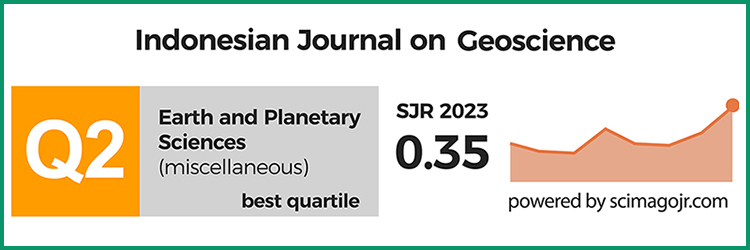High Sulphidation Mineralization and Advanced Argillic Alteration within Concealed Gajah Tidur Porphyry, Grasberg District, Papua
DOI:
https://doi.org/10.17014/ijog.11.1.15-33Abstract
High sulphidation (HS) mineralization and associated advanced argillic alteration have been intersected by three drill holes below the Grasberg porphyry Cu-Au deposit, known as the Gajah Tidur prospect. The prospect is located between 1,500 ̶ 2,750 m level, in Grasberg District, Papua, Indonesia. The holes are of KL98-10-21, KL98-10-22, and GRD39-08 which intersected 3.4 Ma Gajah Tidur monzonite, Grasberg Igneous Complex, the wall rocks of Kembelangan, and New Guinea Limestone Group. This research aims to determine the characteristics of high sulphidation mineralization associated with advanced argillic alteration at Gajah Tidur. Petrographic, XRD, SEM, fluid inclusion, and XRF (geochemical) analyses were applied to identify the mineralogy, geochemistry, and ore fluid properties. The major element plots show a differentiated intrusion. The alteration consists of potassic materials composed of biotite and K-feldspar, overprinted by phyllic and advanced argillic ones typified by alunite, pyrophyllite, and kaolinite. The high sulphidation mineralization characterized by pyrite-covellite, chalcopyrite-chalcocite, enargite, and digenite is also present. Fluid inclusion homogenization temperature of mineralized quartz vein ranges from 393 to 542°C, indicating a magmatic fluid origin predominantly. Two distinct porphyry systems, consisting of the Gajah Tidur Cu-Mo and the Main Grasberg Cu-Au porphyry systems are emplaced at the Gajah Tidur level. Advanced argillic is less intense compared to a pervasive phyllic alteration, overprinting the stockwork and surrounding rocks, emplaced at the upper part of quartz stockwork. It is possibly associated with a late stage of Gajah Tidur porphyry hydrothermal fluids which became cooler and highly acidic. Similar to other porphyry systems such as Oyu Tolgoi in Mongolia, the Gajah Tidur porphyry did not have its hydrothermal fluid ascent to the surface to form lithocap. Instead, the ascending fluids cooled at shallower depths resulting in the formation of advanced argillic alteration.
Downloads
Published
Versions
- 17-05-2024 (2)
- 30-01-2024 (1)



















